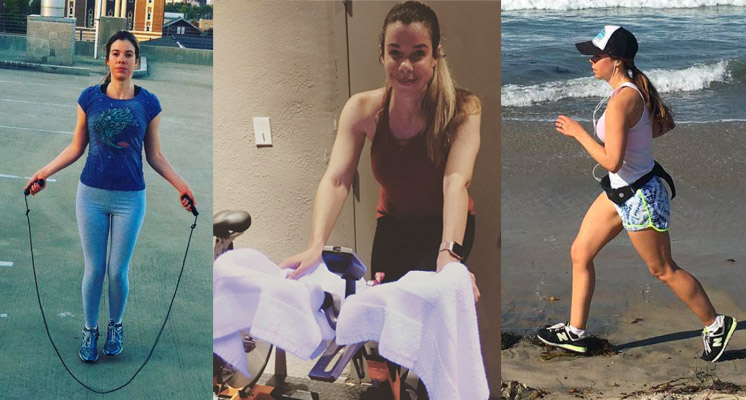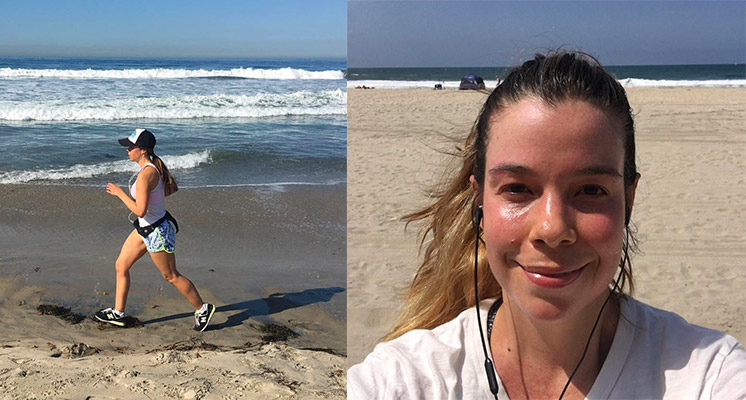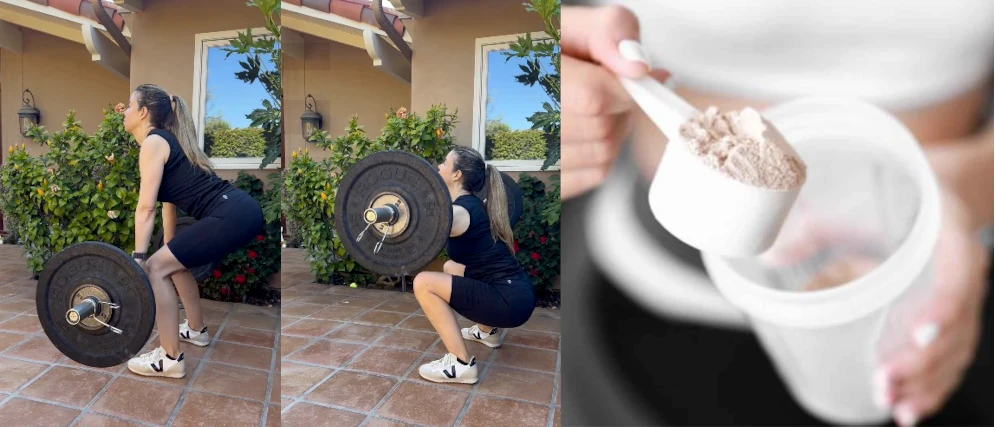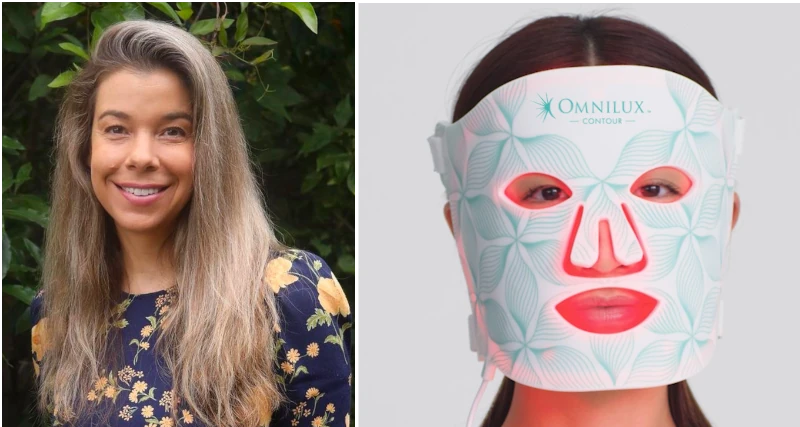Previously we looked at Rhonda’s diet and the supplements she takes. In this post we’ll look at her exercise routine + scientific reasoning behind it. We all know that exercise is good (no-one but Donald Trump seems to argue with that), but it can be extra motivating to learn the scientific benefits.
Each week Rhonda aims to include:
- Endurance Training – specifically Rhonda opts for Running
- High Intensity Training – specifically Rhonda opts for Spinning classes (stationary bike class) or Squat Jumps
- Resistance/Strength Training – specifically Rhonda opts for lunges, squats & other weight lifting exercises
- Stretching/Flexibility – specifically Rhonda opts for yoga and ballet exercises
Rhonda explains that the top 3; endurance, high intensity & resistance training are necessary to stave off muscle aging.
This is important to realize, because many of us get comfortable in exercise routines of limited variety. If we get comfortable just doing endurance training like running or cycling, then we might miss out on the muscle preserving benefits of weight lifting. Vice-versa, if we only do weight lifting – we may miss out on the mitochondrial benefits of endurance training. Below are specific benefits of each type of exercise:
Endurance Training – Prevents age related decline in mitochondrial respiratory capacity – helping your muscle cells produce ATP similar to your younger self
High Intensity Training – Boosts mitochondrial biogenesis – increasing the number of young, healthy mitochondria your body makes
Resistance/Strength Training – Maintains or increases muscle mass, strength & power – all of which decline without training
1. Endurance Training
Rhonda usually goes for a 3 mile run about 3x per week – in part for the cognitive boost it gives her. She notes that when she has a big decision to make, or when something is causing her anxiety, she’s especially enthusiastic to go for a run.
Rhonda: Aerobic exercise (which is what endurance training is) has been shown to increase the growth of new neurons in the brain by two-fold1The Effects of Aerobic Exercise Intensity and Duration on Levels of Brain-Derived Neurotrophic Factor in Healthy Men – Schmolesky et al. (2013). Aerobic exercise even starting in mid life has been shown to almost completely reverse the structural changes that occur in the brain with aging.
High Intensity Training
Rhonda talks about using spinning and squat jumps as methods of high intensity training. She picked up spinning after the birth of her son – and thinks it played a role in helping avoid postpartum depression. If you’re not familiar with spinning, this link explains more.
Rhonda: High-intensity interval training has been shown to increase mitochondrial capacity in younger people by 49%, and, 69% in older people after 3 weeks. It also improved insulin sensitivity and increased mitochondrial proteins and ribosomes (which make new proteins) in their muscle cells2Enhanced Protein Translation Underlies Improved Metabolic and Physical Adaptations to Different Exercise Training Modes in Young and Old Humans – Robinson et al. (2017).
Resistance/Strength Training
Rhonda lifts some weights and does lunges and squats with weights 2-3x per week.
Rhonda: It is really important to maintain muscle mass. Starting in middle age, people lose between 0.5% to 1% of muscle mass per year. One study involving over 300 twins speaks to the importance of the legs in particular: greater strength and power in the legs in particular was associated with an increased brain volume 10 years later and less brain aging in over 300 twins3Kicking Back Cognitive Ageing: Leg Power Predicts Cognitive Ageing after Ten Years in Older Female Twins – Steves et al. (2016). Other fitness measures besides that of the legs, such as forced expiratory volume or grip strength, were not associated with brain aging when leg power was excluded. Other lifestyle and health measures such as frailty and telomere length indicated that reverse causation is not likely. To get right down to it: don’t skip leg day.
Flexibility/Mobility Training
As mentioned above, Rhonda uses yoga and ballet stretches to maintain and improve her flexibility. On top of all the mobility benefits that come with staying flexible, stretching has also been shown to slow tumor growth in mouse models.
Rhonda on Further Benefits of Exercise
Exercise promotes the growth of new neurons
The role of neurons in the brain is communication and processing. In our constantly evolving world, these neurons need constant renewal in order to keep up with developments. One of the bodies signalling mechanisms for neuronal growth is called “brain derived neutrophic factor”, or, BDNF for short. In the study cited by Rhonda below, it shows 20-40 minutes of aerobic exercise triggered a 32% increase in BDNF. Thus we have a natural tool we can use to trigger neuronal upkeep and renewal.
See this footnote4The Effects of Aerobic Exercise Intensity and Duration on Levels of Brain-Derived Neurotrophic Factor in Healthy Men – Schmolesky et al. (2013) for the study in Rhonda’s tweet above.
Improved Learning & Memory Retention
Anecdotally, many runners (and other aerobic enthusiasts) may notice that exercise is a good time for memory processing and consolidation. The below study cited by Rhonda, they were able to show that people who exercised for 15 minutes after learning a new motor skill (i.e. something involving movement) performed better than those who did not. As Rhonda points out, the benefits were only shown after a sleep (sleep being another great memory consolidation mechanism).
See this footnote515-minutes of exercise creates optimal brain state for mastering new motor skills – Dal Maso et al. (2018) for the study in Rhonda’s tweet above.
Delaying Biological Aging (Measured via Telomere Length)
In a study of people’s lifestyles, tests showed that those who partook in regular high intensity exercise had on average 9-year younger telomeres. Telomeres being the caps on the end of our DNA strands, there to protect the DNA from damage. Analogous (kind of) to telomeres are phone cases; we use these to take the brunt of the damage when we drop our phones. And as long as the phone cases are in good condition, our phones are safe. But should the phone cases get damaged or worn down, it leaves the precious contents of the case vulnerable to damage. Likewise, should our telomeres wear out completely, our DNA is highly vulnerable to damage also.
Something interesting, tangentially related to this is the idea of aging itself. For a long time I used to think that it was possible to use a single proxy (such as telomere length) in order to measure biological aging. In fact, it’s not true. A good analogy to our physical aging is the aging of a car. Measuring the wear and tear of any single part of the car does not give us a comprehensive indication of the cars age. For example, if we looked at the well-kept body of the car, we might think it in great condition, but we would miss the worn out brake pads, that at any minute could go. Likewise, with humans, we can use a variety of markers for biological aging. However, it’s very hard to get a comprehensive picture, given that there are so many areas that are aging.
See this footnote6Physical activity and telomere length in U.S. men and women: An NHANES investigation – Tucker et al. (2017) for the study in Rhonda’s tweet above.
Reduced Immune System Decline
As we age our immune system declines naturally – we’re all familiar with the idea of the elderly being vulnerable to illness that their younger selves may have shrugged off. The study below that Rhonda cites, shows older people who exercised regularly exhibited immune system function they would expect from people 30 years their junior.
See this footnote7Major features of immunesenescence, including reduced thymic output, are ameliorated by high levels of physical activity in adulthood – Duggal et al. (2018) for the study in the article above.
Reduced Muscle Aging
As we age we lose muscle, which can lead to problems further down the line with reduced mobility and increased frailty. One method of delaying these muscle loss effects is to keep exercising into later life. The study Rhonda cites below shows how all types of exercise stave off muscle aging.
See this footnote8Exercise Promotes Healthy Aging of Skeletal Muscle – Cartee et al. (2016) for the study in Rhonda’s above tweet.
Closing Remarks
Hopefully that’s given you a window into how Rhonda views exercise, why she does what she does, and the potential benefits you can get from it.
If you value the research and content that Rhonda is putting out, consider signing up become a premium member on her site. Firstly, this crowd sponsored support allows her to continue to work independently, without being reliant on sponsors or grants. Secondly, premium members get a number of exclusive benefits, including members only emails, monthly Ask Me Anything live streams and open access to use her genetics reports.
If you’re looking for more Rhonda Patrick content, below are some further posts I’ve written:
- A detailed post on Rhonda’s diet – including examples of her breakfast, lunch and dinner (link)
- A relatively comprehensive list of supplements that Rhonda has discussed taking, some daily, some for specific use-cases (link)
- Notes on many of the key things Rhonda has discussed about pregnancy, breastfeeding & baby health – based on her journey into motherhood (link)
References
- 1
- 2
- 3
- 4
- 515-minutes of exercise creates optimal brain state for mastering new motor skills – Dal Maso et al. (2018)
- 6Physical activity and telomere length in U.S. men and women: An NHANES investigation – Tucker et al. (2017)
- 7
- 8Exercise Promotes Healthy Aging of Skeletal Muscle – Cartee et al. (2016)











